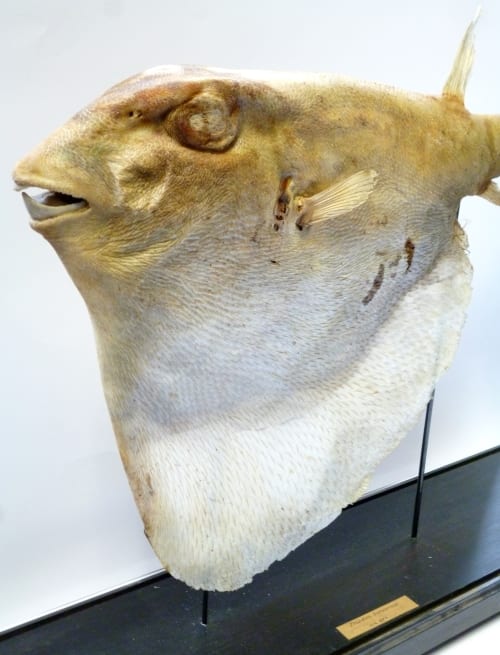Specimen of the Week 207: Threetoothed pufferfish
By Dean W Veall, on 28 September 2015
Hello Specimen of the Week readers. Dean Veall here. I’ve chosen a specimen that’s often caught my eye but I was never too sure about what type of fish it actually was. It is possibly the specimen in the Museum with the least representative name. I give you this week’s Specimen of the Week ….
**The Threetoothed pufferfish (Triodon macropterus)**
1). When is a tooth a beak?
This species of fish are so called because they, unsurprisingly, have three teeth or would have had three teeth were they not fused into a beak. They are found primarily in the waters of the Indio-Pacific living at depths of up to 300m. So why the beak? This is a distinctive characteristic of not only this species but also other members of this order of fish known as the Tetraodontiformes and is the ideal tool for crushing the hard shells of invertebrate prey such as crustaceans and molluscs. Personally, not to knock René Lesson (the French naturalist who gave this species its name), but I think the tooth thing is the least deserving feature that should have been used to name this fish: I would have gone with “Big Flapped pufferfish”.
2). The Tetraodontiformes
Such a bizarre and fascintating group of fish! Our flappy looking specimen is just one of around 349 species that belong to the Tetraodontiformes and all of which are incredibly charismatic. In this group you are going to find boxfish such as the honeycomb cowfish (Acanthostracion polygonius):
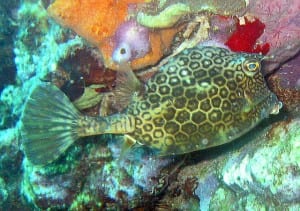
Honeycomb cowfish – “Lactophrys polygonia” by Jan Derk – http://en.wikipedia.org/wiki/Image:Honeycomb_cowfish.jpg. Licensed under Public Domain via Commons – https://commons.wikimedia.org/
or the disc shaped ocean sunfish (Mola mola):

Ocean Sunfish (Mola mola) “Sunfish2” by Per-Ola Norman – Own work. Licensed under Public Domain via Commons – https://commons.wikimedia.org
or filefish like the fan-bellied leatherjacket (Monacanthus chinensis:
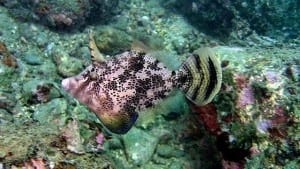
“Monocanthus chinensis1″ by Diver Vincent – Own work. Licensed under CC BY-SA 3.0 via Commons – https://commons.wikimedia.org
Also in the Tetraodontiformes are porcupine fish (Diodon sp.), triggerfish and the ‘superstar’ of the order: the pufferfish. These ray-finned fishs have some highly derived characteristics and are thought to have descended from a coral dwelling ancestor some 40 million years ago. These famous characteristics have not gone unoticed by us land-dwelling beasts whereby in 2005 Mercedes-Benz created the Bionic car which was inspired by the yellow boxfish (Ostracion cubicus) emulating the shape of the fish to replicate the supposed low drag coefficient. See the similarities?
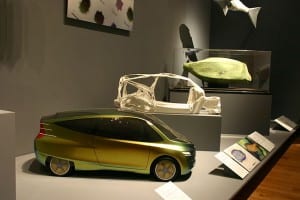
“Mercedes-Benz bionic car” by Ryan Somma – originally posted to Flickr as Mercedes-Benz bionic car. Licensed under CC BY-SA 2.0 via Commons – https://commons.wikimedia.org

“Kofferfisch (Ostracion cubicus) 02″ by Norbert Potensky – Own work. Licensed under CC BY-SA 3.0 via Commons – https://commons.wikimedia.org
Imagine what the threetoothed pufferfish could inspire engineers of the future! Answers on a postcard please.
3). The flap
Like its relatives with their spines weirdly shaped bodies, the bizzare flap of skin that extends beneath the body of the fish is used as a defence mechanism against predation. When alarmed it will use seawater, just like porcupinefish, to inflate this flap to appear larger that it seems. Just visible on our sun-bleached specimen is a black eye spot (it looks more like 2 black marks) that is designed to scare off potential predators. Unlike our specimen, a freshly caught specimen is quite distinctive in colouration:
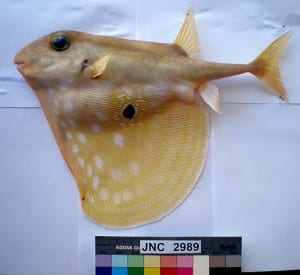
“Triodon macropterus JNC2989″ by Jean-Lou Justine – Own work. Licensed under CC BY-SA 3.0 via Commons – https://commons.wikimedia.org
4). To Nottingham and back
The black-spot keeled pufferfish, (to use it’s other and slightly more descriptive name) has not just mooched around the cabinets and cupboards of the Museum, it seemingly caught the eye of artist Klaus Weber back in 2011 where it featured in his show If You Leave Me I’m Not Coming at the Nottingham Contemporary art gallery which investigated . Along with our water buffalo horns, python skeleton and armadillo specimens, “Big Flap” (I’m trying it out) featured in a display called Already There that was part of his exhibition. In the display the artist brought together an array of 200 objects from a variety of different disciplines and created a work that challenged visitors’ understanding of classification and systems of thought. See if you can spot Flap-man in the video:
5). Little known
Mostly because of the depths these fish live in, not much is known about their natural history. When on the rare chance they are foul hooked by fishermen, the icthyology world goes wild and these be-flapped fish make a note-worthy news story. Such was the case in 2014 when one specimen was caught and made it to the front page (possibly) of South Africa’s Dispatch Live.
Dean Veall is Learning and Access Officer at the Grant Museum of Zoology
 Close
Close


